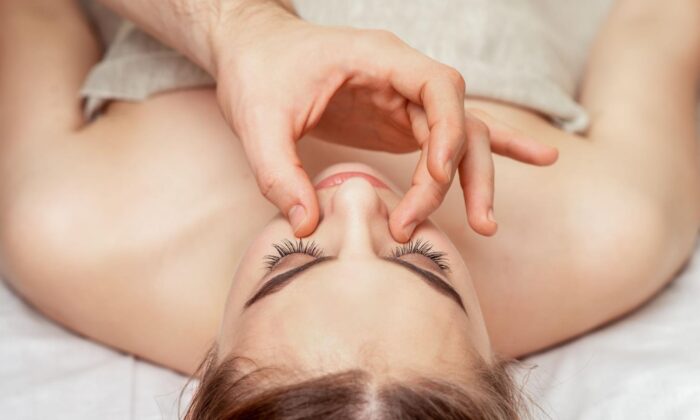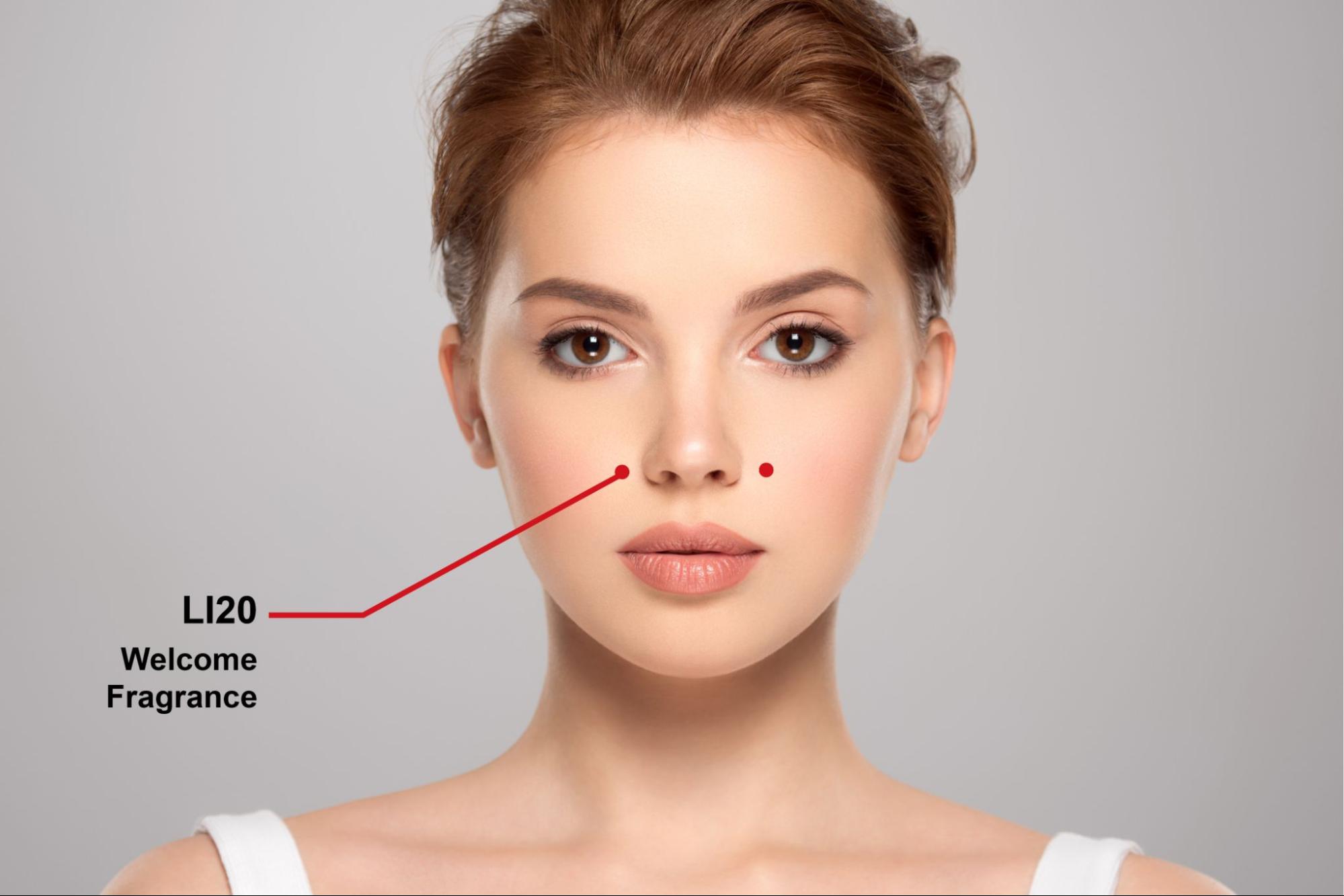How to Clear Stuffy Nose? Massage 2 Acupressure Points for Quick Relief
Nasal congestion is a common symptom, which is the result of inflammation of the nasal mucosa and swelling of the turbinates. Nasal congestion is often a symptom of the beginning of a cold or rhinitis, but if the cold or rhinitis is not cured in time, it may become chronic rhinitis. In the book “Shiming” from the Eastern Han Dynasty, it is written that “rhinitis for a long time, congestion of the nose for a long time, and then suffocation.” Ancient Chinese has many expressions of suffocation to describe the symptoms of nasal congestion. Cure a Cold in Time to Cure a Stuffy Nose Since most nasal congestion is often caused by colds, timely curing a cold can cure the symptoms of nasal congestion and runny nose. The concept of cold in Chinese medicine is different from that in Western medicine. Regardless of the foreign bacteria and viruses, Chinese medicine mainly focuses on the overall symptoms of the body after the onset of the disease and treats it according to the type of cold syndrome. If the symptoms are fever and aversion to cold, nasal congestion, runny nose, no sweat, headache, soreness in the joints of the whole body, and a floating and tight pulse, it is a “wind-cold-type cold,” and it can be cured with the prescription of dispelling wind and dispelling cold. Fever, stuffy nose, yellow turbid nasal discharge, dry mouth, excessive drinking, and floating pulse belong to “wind-heat type cold,” and it can be cured by giving pungent and cooling prescriptions. Therefore, if acute cold rhinitis can be treated well, there will be no sequelae of long-term nasal congestion. What Should be Done If the Nasal Congestion Is Not Cured for a Long Time? In the treatment of long-term nasal congestion (chronic rhinitis), Chinese medicine treats this with appropriate prescriptions according to the syndrome and the local symptoms of the nasal mucosa and turbinate, and the outcome is usually good. Patients with chronic rhinitis often have symptoms such as headache, dizziness, obstructive nasal sound, and deafness of the ear, in addition to the symptoms of nasal congestion, profuse nasal discharge, and hyposmia. Generally speaking, patients with long-term nasal congestion can be treated with Center-Supplementing and Qi-Boosting Decoction if they have a qi deficiency constitution. In addition, Chinese medicine believes that “long-term illness will inevitably lead to blood stasis,” long-term nasal congestion, swelling and hypertrophy of turbinates, and poor microcirculation can be treated with drugs that promote blood circulation, remove blood stasis and clear orifices, such as “Blood Stasis-Expelling Decoction.” The advantage of traditional Chinese medicine in treating nasal diseases is that there is no side effect of fatigue or drowsiness, on the contrary, mental and physical strength will become better. Since chronic rhinitis is a chronic disease, it will take time to cure it completely. It is necessary to take traditional Chinese medicine for a period of time to improve the constitution and consolidate the curative effect. Massage 2 Acupuncture Points to Quickly Relieve Nasal Congestion If you have a blocked nose, try this acupuncture massage to unblock the airways. 1. Press acupoint LI20 Welcome Fragrance Welcome Fragrance is located in the slight depression beside the bottom edge of the nose, where the nostrils meet the face. Press and rub the acupoints on both sides with your fingers for two to three minutes at a time. Massaging Welcome Fragrance acupoint can improve nasal congestion. (By The Epoch Times/Shutterstock) To massage the Welcome Fragrance acupoint, form hollow fists with fingers of each hand, and press the thumbs tightly against the first fingers. Use the side of the thumb knuckles nearest the body to rub the acupuncture point up and down until the nose is clear. 4 Tips to Avoid Worsening Nasal Congestion Rhinitis and nasal allergies are also related to our lifestyles. Reminding people with nasal diseases to pay more attention to their daily living habits as doing so can prevent nasal congestion from worsening. 1. People who suffer from nasal allergies, nasal congestion, and runny nose should not drink too many cold drinks. 2. Do not eat too many sweets, which will make the body’s metabolism worse, increase the body’s chronic inflammatory response, and is not conducive to the treatment of nasal diseases. 3. Children are prone to sweating within half an hour of falling asleep, and their clothes are prone to becoming wet. If the clothes are not changed in time, it is easy to cause a cold. It is recommended to have children wear “sweat-wicking underwear” to sleep, even if they sweat, the body’s skin remains dry, so it is less likely to cause a cold. 4. Pay attention to the changes in weather and temperature, and add clothes in a timely manner. In cold weather, children should avoid kicking the quilt off their bodies when they sleep in order to prevent the development of a cold.

Nasal congestion is a common symptom, which is the result of inflammation of the nasal mucosa and swelling of the turbinates. Nasal congestion is often a symptom of the beginning of a cold or rhinitis, but if the cold or rhinitis is not cured in time, it may become chronic rhinitis.
In the book “Shiming” from the Eastern Han Dynasty, it is written that “rhinitis for a long time, congestion of the nose for a long time, and then suffocation.” Ancient Chinese has many expressions of suffocation to describe the symptoms of nasal congestion.
Cure a Cold in Time to Cure a Stuffy Nose
Since most nasal congestion is often caused by colds, timely curing a cold can cure the symptoms of nasal congestion and runny nose. The concept of cold in Chinese medicine is different from that in Western medicine. Regardless of the foreign bacteria and viruses, Chinese medicine mainly focuses on the overall symptoms of the body after the onset of the disease and treats it according to the type of cold syndrome.
If the symptoms are fever and aversion to cold, nasal congestion, runny nose, no sweat, headache, soreness in the joints of the whole body, and a floating and tight pulse, it is a “wind-cold-type cold,” and it can be cured with the prescription of dispelling wind and dispelling cold. Fever, stuffy nose, yellow turbid nasal discharge, dry mouth, excessive drinking, and floating pulse belong to “wind-heat type cold,” and it can be cured by giving pungent and cooling prescriptions. Therefore, if acute cold rhinitis can be treated well, there will be no sequelae of long-term nasal congestion.
What Should be Done If the Nasal Congestion Is Not Cured for a Long Time?
In the treatment of long-term nasal congestion (chronic rhinitis), Chinese medicine treats this with appropriate prescriptions according to the syndrome and the local symptoms of the nasal mucosa and turbinate, and the outcome is usually good.
Patients with chronic rhinitis often have symptoms such as headache, dizziness, obstructive nasal sound, and deafness of the ear, in addition to the symptoms of nasal congestion, profuse nasal discharge, and hyposmia. Generally speaking, patients with long-term nasal congestion can be treated with Center-Supplementing and Qi-Boosting Decoction if they have a qi deficiency constitution. In addition, Chinese medicine believes that “long-term illness will inevitably lead to blood stasis,” long-term nasal congestion, swelling and hypertrophy of turbinates, and poor microcirculation can be treated with drugs that promote blood circulation, remove blood stasis and clear orifices, such as “Blood Stasis-Expelling Decoction.”
The advantage of traditional Chinese medicine in treating nasal diseases is that there is no side effect of fatigue or drowsiness, on the contrary, mental and physical strength will become better. Since chronic rhinitis is a chronic disease, it will take time to cure it completely. It is necessary to take traditional Chinese medicine for a period of time to improve the constitution and consolidate the curative effect.
Massage 2 Acupuncture Points to Quickly Relieve Nasal Congestion
If you have a blocked nose, try this acupuncture massage to unblock the airways.
1. Press acupoint LI20 Welcome Fragrance
Welcome Fragrance is located in the slight depression beside the bottom edge of the nose, where the nostrils meet the face. Press and rub the acupoints on both sides with your fingers for two to three minutes at a time.

To massage the Welcome Fragrance acupoint, form hollow fists with fingers of each hand, and press the thumbs tightly against the first fingers. Use the side of the thumb knuckles nearest the body to rub the acupuncture point up and down until the nose is clear.
4 Tips to Avoid Worsening Nasal Congestion
Rhinitis and nasal allergies are also related to our lifestyles. Reminding people with nasal diseases to pay more attention to their daily living habits as doing so can prevent nasal congestion from worsening.
1. People who suffer from nasal allergies, nasal congestion, and runny nose should not drink too many cold drinks.
2. Do not eat too many sweets, which will make the body’s metabolism worse, increase the body’s chronic inflammatory response, and is not conducive to the treatment of nasal diseases.
3. Children are prone to sweating within half an hour of falling asleep, and their clothes are prone to becoming wet. If the clothes are not changed in time, it is easy to cause a cold. It is recommended to have children wear “sweat-wicking underwear” to sleep, even if they sweat, the body’s skin remains dry, so it is less likely to cause a cold.
4. Pay attention to the changes in weather and temperature, and add clothes in a timely manner. In cold weather, children should avoid kicking the quilt off their bodies when they sleep in order to prevent the development of a cold.












